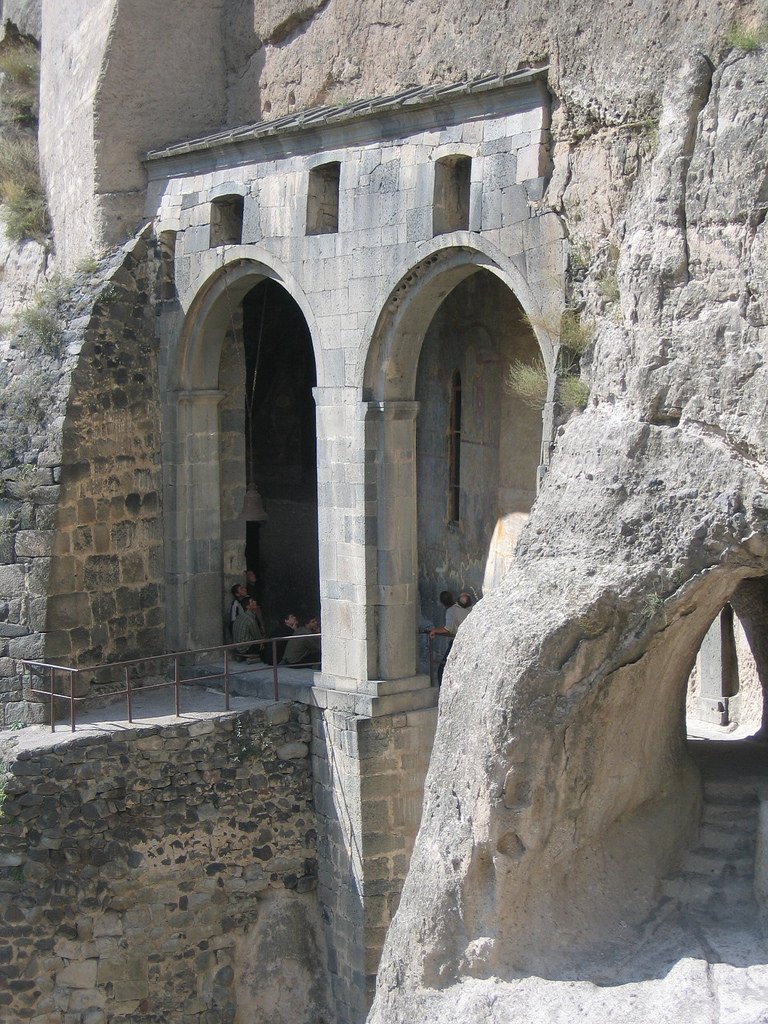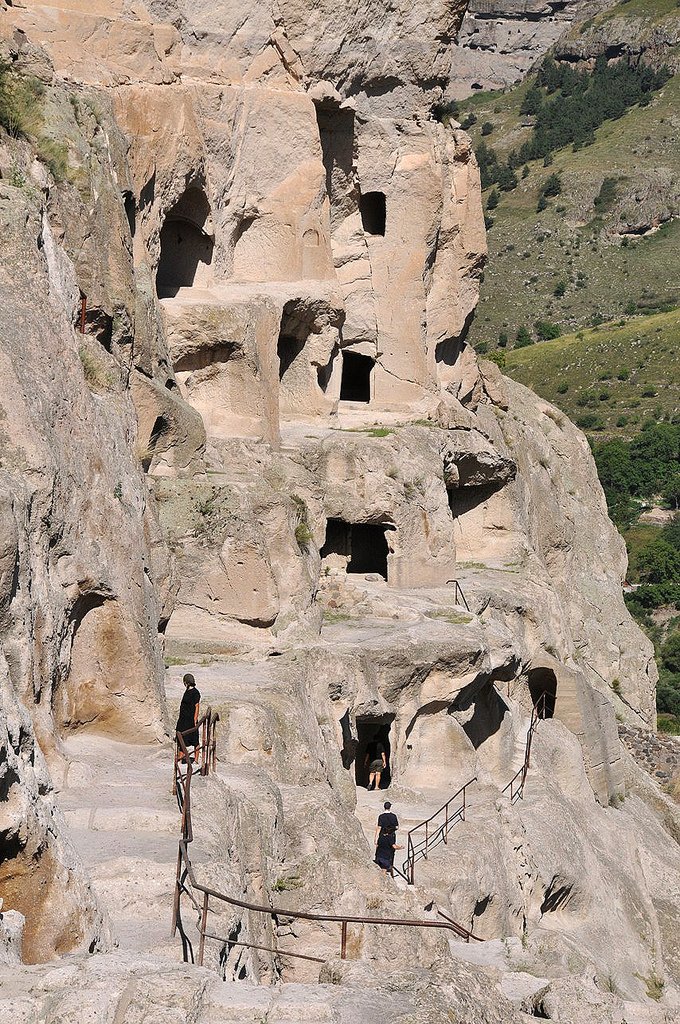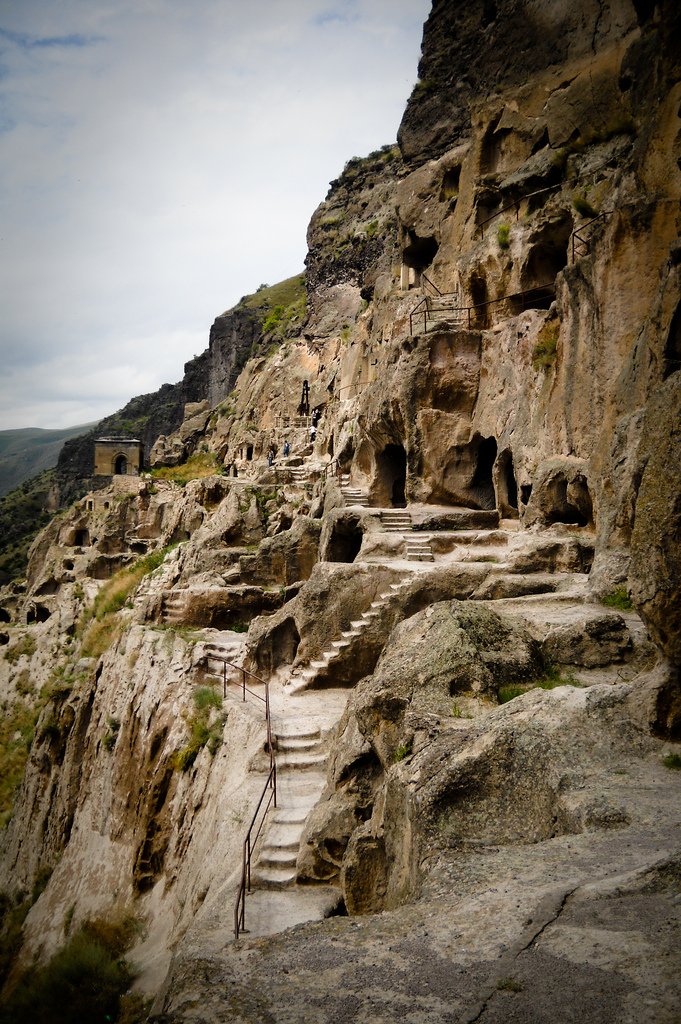Endymion
Spring and Roses.
- Messages
- 2,166
- Reaction score
- 684
- Gender
- Female
- Religion
- Islam
The Cave City of Vardzia is remarkable. Situated in the European country of Georgia at the juncture of Eastern Europe and Western Asia it has an over eight hundred year history. Yet you would be forgiven for wondering why such a place was built in the first place. The words why and how spring immediately to mind.

1185 saw a woman, Tamar, on the throne of Georgia. This was a first for the country and extremely unusual in the Europe of the twelfth century. Her reign nevertheless, saw a flowering of culture and she wished to build a monastery. There was, however, a problem: the Mongols.


The Mongol empire had been inexorably expanding and little Georgia was under threat constantly. What better an idea, then, for their fabled Queen to have her monastery carved from solid rock. It looks like it is the ruins of some giant Tolkien city, Minas Tirith in ruins. Yet this was not to be the home of dwarves but of monks – and many of them.


Desperate times lead to desperate measures and to help her people avoid the Mongol onslaught, Tamar commanded that an underground sanctuary be built. The town of Aspindza was chosen and the secret work began under the nearby Erusheli Mountain.


The queen (seen left on a mural from inside the monastery) was twenty five years old when the construction work began and had been on the throne only a year.
Nobles tried persistently to usurp her position, on grounds of her relative immaturity and of course her gender but she ruled for 29 years. A warrior queen she is still revered by many in Georgia.



Vardzia would be a massive construction job now but in the twelfth century it was a gigantic, epic labor one which was fuelled by both the adherence to the Christian faith and the Georgian determination that their lifestyle and culture should not be destroyed by the invading Mongols.


Altogether, 13 levels were constructed with natural caves being enlarged to contain over 6,000 dwelling places for monks and for those fleeing invaders. The only way to get to this underground kingdom was via a secret tunnel which started at the nearby Mtkvari river.

On the outside of the hidden monastery the land of the mountain was extremely fertile. The monks created a system of irrigated terraces that would feed those inside. Hidden within the mountain and perhaps the first example of an eco-friendly self-sustainable (in terms of food and water) structure in Europe, it must have been considered impregnable. Yet nature had an unpleasant surprise for the cave city of Vardzia.

The city escaped the Mongols triumphantly. Yet less than a hundred years after its construction, the great earthquake of 1283 brought devastation to the country. It was so powerful that it ruptured the cave system, causing much of it to collapse and cascade down the side of the Erusheli Mountain.

If you look closely at the two pictures above you will notice the remnants of the terrace walls on the top of the mountain. You will also be able to make out where the mountain simply sheared off and simply dropped to the ground below, exposing the monastery within. The event was cataclysmic.


It must have seemed like a punishment of god to the residents of the city, perhaps retribution for the pride they had taken in successfully defending their nation from the Mongols. Two thirds of the hidden city was destroyed – and its unseen intestines were exposed to the world on the side of the mountain.


The monastery, more than simply decimated, did not give up. It continued until 1551 but was then attacked and pillaged by the Persian Sash Tahmasp who slaughtered the monks. It was then that Vardzia was finally abandoned.

Yet in the twentieth century the monastery was revisited by monks who decided to guard its history and a small group remain there to this day. It is more of a museum now than a monastery but still serves as a reminder of the extremes a people will go to in order to protect their culture as well as the savage vagaries of nature.


1185 saw a woman, Tamar, on the throne of Georgia. This was a first for the country and extremely unusual in the Europe of the twelfth century. Her reign nevertheless, saw a flowering of culture and she wished to build a monastery. There was, however, a problem: the Mongols.


The Mongol empire had been inexorably expanding and little Georgia was under threat constantly. What better an idea, then, for their fabled Queen to have her monastery carved from solid rock. It looks like it is the ruins of some giant Tolkien city, Minas Tirith in ruins. Yet this was not to be the home of dwarves but of monks – and many of them.


Desperate times lead to desperate measures and to help her people avoid the Mongol onslaught, Tamar commanded that an underground sanctuary be built. The town of Aspindza was chosen and the secret work began under the nearby Erusheli Mountain.


The queen (seen left on a mural from inside the monastery) was twenty five years old when the construction work began and had been on the throne only a year.
Nobles tried persistently to usurp her position, on grounds of her relative immaturity and of course her gender but she ruled for 29 years. A warrior queen she is still revered by many in Georgia.



Vardzia would be a massive construction job now but in the twelfth century it was a gigantic, epic labor one which was fuelled by both the adherence to the Christian faith and the Georgian determination that their lifestyle and culture should not be destroyed by the invading Mongols.


Altogether, 13 levels were constructed with natural caves being enlarged to contain over 6,000 dwelling places for monks and for those fleeing invaders. The only way to get to this underground kingdom was via a secret tunnel which started at the nearby Mtkvari river.

On the outside of the hidden monastery the land of the mountain was extremely fertile. The monks created a system of irrigated terraces that would feed those inside. Hidden within the mountain and perhaps the first example of an eco-friendly self-sustainable (in terms of food and water) structure in Europe, it must have been considered impregnable. Yet nature had an unpleasant surprise for the cave city of Vardzia.

The city escaped the Mongols triumphantly. Yet less than a hundred years after its construction, the great earthquake of 1283 brought devastation to the country. It was so powerful that it ruptured the cave system, causing much of it to collapse and cascade down the side of the Erusheli Mountain.

If you look closely at the two pictures above you will notice the remnants of the terrace walls on the top of the mountain. You will also be able to make out where the mountain simply sheared off and simply dropped to the ground below, exposing the monastery within. The event was cataclysmic.


It must have seemed like a punishment of god to the residents of the city, perhaps retribution for the pride they had taken in successfully defending their nation from the Mongols. Two thirds of the hidden city was destroyed – and its unseen intestines were exposed to the world on the side of the mountain.


The monastery, more than simply decimated, did not give up. It continued until 1551 but was then attacked and pillaged by the Persian Sash Tahmasp who slaughtered the monks. It was then that Vardzia was finally abandoned.

Yet in the twentieth century the monastery was revisited by monks who decided to guard its history and a small group remain there to this day. It is more of a museum now than a monastery but still serves as a reminder of the extremes a people will go to in order to protect their culture as well as the savage vagaries of nature.

